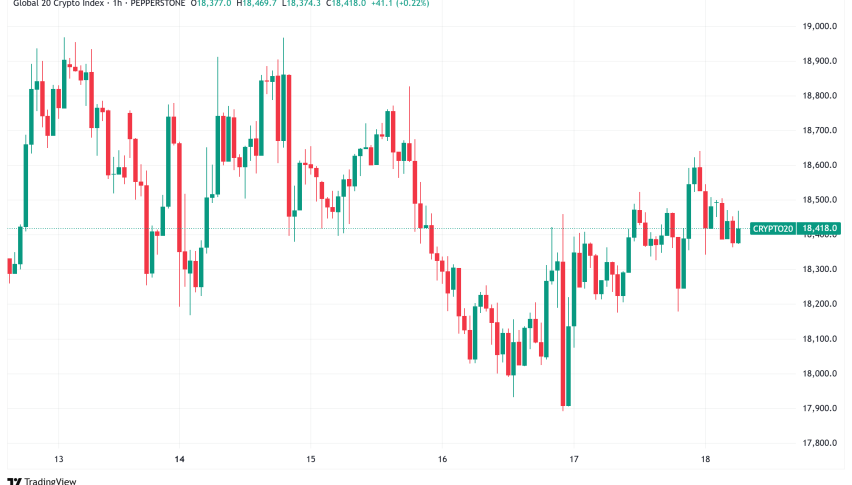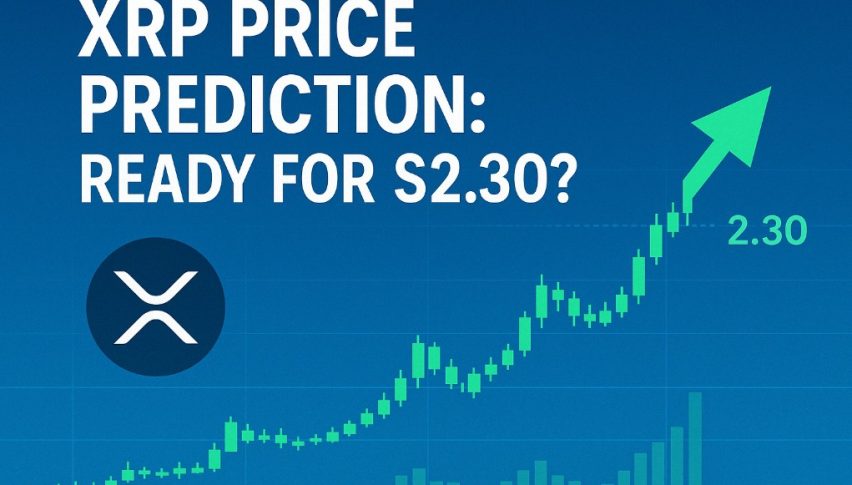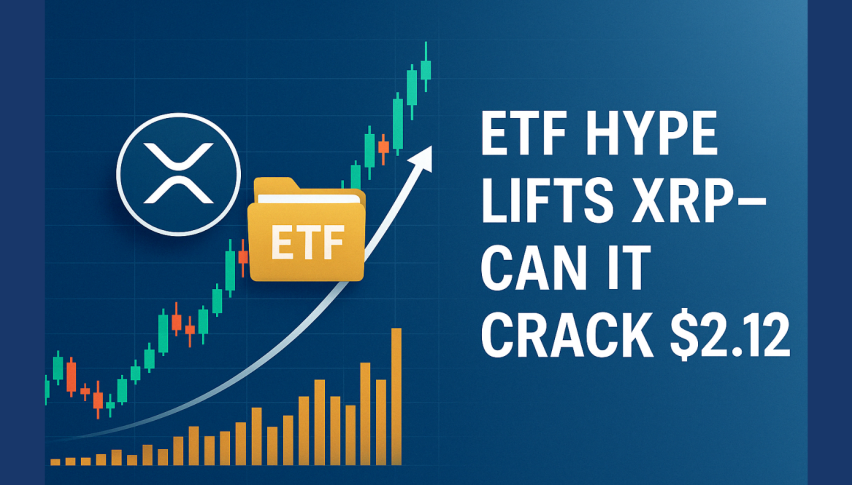Ripple (XRP) – Forecast Summary
| XRP Forecast: End 2021 Price: $1.20-1.40 Price drivers: Waning bullish crypto sentiment, XRPs in circulation, SEC legal battle being priced into the market | XRP Forecast: 1 Year Price: $1.80-$2.00 Price drivers: Crypto sentiment, Ripple adoption, Ripple coin sales, SEC ruling? | XRP Forecast: 3 Years Price: $3.50-$5.00 Price drivers: Increased competition, further regulation, possible legal fallout from 2021 SEC judgment |
Ripple has been showing signs of weakness since the September reversal down in the market. Other major cryptos such as Ethereum and Bitcoin are heading for all-time highs in October, but Ripple is still trading above $1. Cryptocurrencies came down to earth after the crash in May, which followed a massive surge in April for Ripple coin, that took the price from around $0.50 to almost $2. Every such bullish move is usually followed by a reversal, like the one in early 2018, which followed a surge at the end of 2017. Although, this recent pullback doesn’t exactly look like that one and as of August, Ripple is resuming the bullish trend again after doubling in price already since the lows around $0.50. Ripple coin held to some of the gains, which was the first sign indicating that this wasn’t going to be the same as 2018. The bullish momentum has resumed again and despite the legal battle with SEC, which is slowly progressing, Ripple buyers remain in charge again.
The fourth quarter of 2020 (Q4) was a pivotal time for cryptocurrencies although Ripple didn’t benefit much from it. Strong bullish sentiment dominated the asset class as coronavirus (COVID-19) and political uncertainties began to reside, which turned even more bullish in 2021, until mid-May. With the new president in the U.S. and the final conclusion to the Brexit saga, as well as the global economic reopening drove optimism across many asset classes. Long gone was the COVID-19 panic selling of March 2020 ― in its place was recovery-fueled optimism for the global economy, but that didn’t deter cryptocurrencies, which have resumed the bullish trend.
Q4 2020 and Q1 2021 proved to be a bullish period for the leading cryptos. Among the biggest winners were Bitcoin (BTC) and Ethereum (ETH), both establishing new all-time record highs. Unfortunately, Ripple (XRP) didn’t exhibit the epic bidding that many other cryptos did, despite a couple of attempts to join the crypto rally. In Q2 of 2021 XRP/USD finally joined the rally, nearly quadrupling in value in a couple of weeks, before the reversal and the crash in May and the second leg of decline in June. But, the decline stopped by late June and cryptocurrencies including Ripple Coin resumed the uptrend again. XRP/USD moved above $1, gaining around 100% in value in three weeks, which put it back on the bullish trend.
Recent Changes in the Ripple Price
| Period | Change ($) | Change % |
| 30 Days | +0.16 | -36.4% |
| 3 Months | -0.32 | -31.9% |
| 6 Months | +0.44 | +93% |
| 1 Year | +0.72 | +375% |
| 3 Years | +0.46 | +105% |
Similar to other cryptocurrencies, the XRP market is driven by a diverse collection of underpinnings. Rumours, government regulation, mainstream adoption, and corporate health are four common market drivers that XRP shares with the rest of the asset class. However, XRP is an exceedingly unique product. Launched in 2012, Ripple has had a longstanding history as being one of the leading coins by market capitalization. Featuring a mammoth float of 100 billion units and an ultra-low price, XRP is thought of by many to be the “silver of cryptocurrencies.” If you can’t afford BTC or ETH, then XRP appears to be a suitable option.
Since its inception, XRP pricing has periodically fallen out of step with the leading cryptocurrencies. One of the main reasons for this is that XRP is only one of several assets promoted by parent company Ripple. In addition, XRP is not “mined” by the public like BTC, ETH, or Litecoin (LTC). Back in 2012, Ripple minted 100 billion XRP, which were to be periodically sold to the public by Ripple. As of 2021, only about 45 billion are in circulation ― the other 55 billion are being held by Ripple for future dissemination. This is an extremely controversial aspect of XRP pricing; theoretically, Ripple can “dump” large blocks of XRP on the market as deemed necessary. Given this functionality, there is a question of whether or not the price of XRP can be directly manipulated by its parent company.
Factors Affecting Ripple Coin
The value of cryptocurrencies with respect to supply and demand is an interesting study. In fact, experts argue that the tight supplies of BTC are the primary reason for its steep 2020/21 rally from $3500 to $50,000. As of January 2020, there were about 18.5 million BTC in circulation, with a maximum supply of 21 million. Basically, BTC’s inherent scarcity prompted a major spike in value as demand increased. The supply/demand dichotomy for XRP is almost 180° from BTC ― there is a ton of XRP available and even more held in reserve. The Ripple coins in circulation and the supply/demand relationship are a major factor for Ripple, but the overall cryptocurrency market sentiment will be impacting any future forecasts of the coin’s value. The adoption by larger companies and institutions is also a major factor. Ripple is making progress in this front, with Ripple labs’ subsidiary RippleNet assisting SBI Remit [SBI’s subsidiary] in building a cheap and frictionless remittance network in Japan.
Monero Coin (XMR) Forecast for 2021: Will the XMR/USD Continue to Rise in 2021?
Ethereum (ETH) Price Prediction For 2021: Will Buyers Break 2017 Highs Soon?
Ripple (XRP): 5-Year Price Prediction
Throughout Q1 of 2021, it would be a challenge to argue against the bullish sentiment that dominated most of the cryptocurrency asset class. Prices reached astronomical highs until the middle of April, as the mainstream adoption of cryptos appeared to be right around the corner. Yet, the future of Ripple and XRP was extremely uncertain. A lawsuit filed by the U.S. Securities Exchange Commission (SEC) against Ripple threatened to severely impact the company, but couldn’t get in the way of the bulls. In addition, a multitude of outsiders stood ready to bring fresh competition to the crypto-banking sector. But, the war on cryptos from China and other global establishment fractions have hurt the sentiment immensely in this market. Ultimately though, the five-year value of XRP will depend upon the revival of this market after the crash and how it fares against the SEC, industry competition, supply in circulation, and aggregate cryptocurrency performance.
How Will Supply And Demand Influence XRP Prices?
No matter if you’re trading stocks, commodities, currencies, or crypto, supply and demand is a key driver of valuations. The general rule is this: if supplies are low and demand is high, prices rise. Beginning in mid-2020 through February 2021, a robust public and institutional demand for cryptos drove prices to record highs. XRP was an outlier ― why? The answer lies in the supply-side relationship between XRP, its parent company Ripple, and the trading public.
Before understanding the XRP supply/demand curve, it’s important to take a look at Ripple’s methodology toward coin management. As of February 2021, Ripple Inc. held approximately 6.3 billion XRP, while placing another 48 billion into a cryptographically-secured escrow account. That left about 45.6 billion XRP of the total 100 billion in public circulation. In effect, Ripple controlled roughly 55 billion XRP, while the public held 45 billion; a 55/45 majority split. As of mid-February 2021, XRP was priced at $0.60, making the entire market cap roughly $60 billion ― Ripple directly owned $33 billion. It stands to reason that when Ripple decides to release more XRP into circulation, prices will be significantly impacted.
To increase the circulating supply of XRP, Ripple must sell coins to buyers. Here’s a look at Ripple’s official sales policy: “Since 2012, Ripple has methodically sold XRP and used it to incentivize market maker activity to increase XRP liquidity and strengthen the overall health of the XRP markets.” In other words, Ripple sells XRP to ensure operational and pricing efficiency. So, how will Ripple manage this moving forward? That is a tricky question. During the second half of 2020, Ripple became increasingly active in the XRP markets. For Q3 2020 (1 July- 30 September), Ripple sold $81.39 million worth of XRP and purchased $45.55 million for a net of $35.84 million. Q4 (1 October-30 December) proved even more aggressive. For Q4, Ripple sold $111.12 million worth of XRP, purchased $34.85 million, for a net of $76.27 million.
The conclusion: as prices rose, Ripple sold more XRP. For Q3 2020, XRP was range bound between $0.17 and $0.25; Q4 saw this range extend north, becoming established between $0.25 and $0.75. The price action of Q4 is worth a closer look. To begin October, XRP traded in the vicinity of $0.23; mid-November brought a spike high of $0.76; as December concluded, prices fell to $0.21. Basically, Ripple began selling XRP, traders followed suit, and prices moved quickly lower.
When considering the massive supply of XRP that Ripple directly controls, new coin sales are an extremely bearish market driver. In the event that Ripple needs an injection of capital, or is forced to disperse escrowed coins, XRP prices will suffer. Until XRP reserves are depleted and the coins-in-circulation become the majority of aggregate supply, Ripple XRP sales will represent a formidable downside risk. Conversely, if Ripple ceases XRP sales for an extended period of time, prices are likely to stabilize or move higher.
Can The SEC Vs Ripple Spoil Valuations?
On 22 December 2020, the United States Securities and Exchange Commission (SEC) announced that it filed suit against Ripple Labs Inc. The SEC’s claim was based on allegations that more than $1.3 billion was raised via an ongoing, unregistered, securities offering. According to the SEC’s complaint, beginning in 2013 co-founder Christian Larsen and CEO Bradley Garlinghouse aided Ripple in the unregistered sale of billions of XRP to finance corporate business. In addition, Garlinghouse and Larsen sold $600 million worth of XRP for personal gain. Basically, the SEC claims that these XRP sales were in violation of federal securities laws. Enforcement Division Director Stephanie Avakian summed up the SEC’s position: “Issuers seeking the benefits of a public offering, including access to retail investors, broad distribution, and a secondary trading market, must comply with the federal securities laws that require the registration of offerings unless an exemption from registration applies. We allege that Ripple, Larsen, and Garlinghouse failed to register their ongoing offer and sale of billions of XRP to retail investors.”
The crux of the SEC vs Ripple is the question of whether or not XRP is a security. In their initial response to the charges, Ripple states that XRP is not an investment contract, but a cryptocurrency. Andrew Ceresney, outside counsel for Ripple, had this to say about the claims: “The SEC’s case is unprecedented and ill-conceived. The SEC has ignored XRP’s clear status as a virtual currency, contradicting not only the findings of other regulatory agencies, but also international regulatory regimes. The SEC is now stretching the concept of an ‘investment contract’ beyond its breaking point.” In theory, Cerenskey has a point. XRP’s function is to facilitate cross-border transactions. Also, it is traded on hundreds of exchanges worldwide, far beyond the reach of the United States SEC. In a 2019 interview with CNBC, SEC Chairman Jay Clayton said this about the asset classification of cryptos: “Cryptocurrencies; these are replacements for sovereign currencies. That type of currency is not a security.” Previously, Clayton reiterated that all initial coin offerings (ICOs) are securities, and “if it’s a security, we’re [SEC] regulating it.”
While it’s always difficult to predict what will happen in court, it appears as though Ripple has a formidable defense. The key aspects of the case are that Ripple never held an ICO for XRP and XRP holders are not entitled to any share of corporate profits. At least with respect to Clayton’s comments, these two items appear to disqualify XRP from being classified as a security. However, it’s no coincidence that this case is being brought as cryptos rally to new heights. The idea of holding cryptocurrencies as investments ― instead of using them for commerce ― is catching on with institutional investors. Through the SEC vs Ripple, it looks like the U.S. government is interested in establishing a powerful new precedent for cryptocurrencies, labelling them securities. This is an extremely invasive move, as every crypto purchase, sale, or transfer, could potentially fall under SEC jurisdiction.
The December 2020 SEC filing brought immense selling to XRP. During the aftermath, traders ran for the hills, initiating a 50% two-day plunge in XRP from $0.50 to $0.25. Although prices rebounded in January 2021, the impact of the litigation was immense. Moving forward, one thing is for sure ― Ripple and XRP are on the U.S. government’s radar. No matter what happens in the SEC vs Ripple 2021, this case is likely only the beginning. Should the SEC be successful in defining XRP as a security, the entire cryptosphere, led by Ripple, will be in for a massive correction.
Does XRP Have A Sustainable Competitive Edge?
At its core, XRP is a tool for streamlining cross-border transfers between financial institutions. Back in 2012, it was marketed as being a cheaper, faster alternative to Bitcoin. Using Ripple’s centralized digital infrastructure, XRP was able to avoid blockchain logjams by eliminating the consensus algorithm needed to facilitate transactions. Using a collection of some 35 XRP “validators,” Ripple can process transactions quickly, within 3-5 seconds. At the time, Ripple and XRP were thought by many to be the future of the banking industry. Companies such as American Express, MoneyGram, and PNC were among the first to adopt the budding technology.
Of course, much has changed since 2012. Competitors such as Stellar, DrumG Technologies, IOTA, and Ethereum have also directed efforts toward the banking industry. In addition, one has to wonder about the possibility of central banks autonomously going crypto. Currently, beta tests on cryptocurrency products are being conducted by the U.S. Federal Reserve (Fed) and European Central Bank (ECB). Predictions from ECB President Christine Lagarde from November 2020 allude to a “Digital Euro” being launched within 2-4 years. If a FedCoin or Digital Euro become a reality, the role of cryptocurrencies in the banking sector is likely to come under intense scrutiny. If the world’s leading central banks establish their own digital ledgers, will the functionality of XRP be needed?
Realistically, it’s impossible to predict the evolution of an asset class as advanced as cryptocurrencies. Nonetheless, if digital currencies become dominated by central banks and governments, XRP may have a hard time finding a niche in the new ecosystem.
Ripple (XRP) Technical Analysis
Before the major bullish momentum of 2021, Q4 of 2020 was an extremely active period for XRP. During the COVID-19 market meltdown of March 2020, XRP posted lows in the area of $0.12. Until late November, a relatively tight trading range became established between $0.15 and $0.32. As cryptocurrency prices exploded during Q4, XRP rose to a high of $0.78 before plunging to $0.17 following the announcement of the SEC’s lawsuit. January and February brought recovery, with prices retesting November’s highs.

Has the pullback ended at the 20 SMA?
By April, Ripple coin surged as the lawsuit didn’t seem to be leading anywhere, while the sentiment in the crypto market improved considerably. XRP/USD jumped above the resistance at $0.80 which was the high since May 2018 and pushed to 1.97. Although, it couldn’t hold those gains, as the crypto market came crashing down in May and June. But the 20 SMA (gray) and the 50 SMA (yellow) turned into support and stopped the decline. July’s candlestick closed as a pin/hammer which is a bullish reversing signal after the decline, August looks bullish already so far, pushing above $1.

XRP/USD is oversold on the weekly chart, as stochastic shows
On the weekly timeframe, XRP/USD used to remain below moving averages, which were providing resistance for the last 3 years from 2018 until Q4 of 2020, when we saw a bullish sign, as buyers pushed above them in November 2020. But that didn’t last and XRP/USD came back down below the MAs, at the end of the year, as the SEC lawsuit was weighing in this cryptocurrency. But, the strong bullish momentum in the crypto market pulled Ripple coin up with it and XRP/UD turned extremely bullish until April. It didn’t last long though and after some ups and downs the price eventually followed the market down. The 20 SMA (gray) was broken and Ripple coin fell to the 50 weekly SMA (yellow) which turned into support. The stochastic indicator was also oversold, which pointed to a bullish reversal and in the last week of July we saw a bullish reversal. But, the 20 SMA still stands above.

The 20 SMA has pushed Ripple below the resistance zone
On the daily timeframe, we see that the 20 SMA (gray) was keeping Ripple bearish, pushing it down since early June. But a support level formed above $0.50 and XRP/USD eventually bounced off that moving average, pushing above all moving averages. So, Ripple is bullish again, but we will see if it will take out the 20 SMA on the weekly chart soon, which is the only obstacle above,




